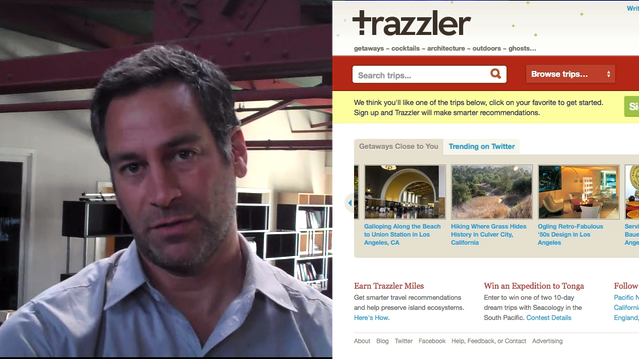![]() At first glance, Trazzler— a travel site that focuses on unique, local destinations— doesn’t seem like an obvious bet. With a handful of employees sprinkled across Florida, California, and Spain, it’s a small startup that operates in a highly competitive market. Its CEO and co-founder, Adam Rugel is well aware that it will never be able to match the huge archives of Frommer’s or Lonely Planet and the company is not profitable.
At first glance, Trazzler— a travel site that focuses on unique, local destinations— doesn’t seem like an obvious bet. With a handful of employees sprinkled across Florida, California, and Spain, it’s a small startup that operates in a highly competitive market. Its CEO and co-founder, Adam Rugel is well aware that it will never be able to match the huge archives of Frommer’s or Lonely Planet and the company is not profitable.
But Trazzler has captured the attention of prominent investors, recently closing a $1.1 million seed round of funding. The round was led by Ron Conway’s SV Angel and included AOL Co-Founder Steve Case, Jack Dorsey, Dave Morin, Betaworks, Founder Collective and AOL Ventures. If success is measured by the company you keep, Trazzler is a company to watch. (See video above, shot on my flip cam)
To be fair, Trazzler has always had a unique advantage relative to other startups: it was born in the offices of Twitter. The co-founder of Twitter, Biz Stone is also a co-founder of Trazzler and Rugel is a former Odeo employee (the company founded by Ev Williams that would eventually give rise to Twitter). Biz Stone remains actively involved in the company as a board member. But beyond the masthead, you can see the fingerprints of Twitter on Trazzler. Like Twitter, users are encouraged to express their thoughts in a limited space: each “published” trip guide is between 60-100 words. People can submit entries that exceed 100 words “but they don’t really get into the Trazzler trip stream…The 140 character limit didn’t have the effect of limiting people’s creativity it made them be more creative within those limits and I think our limited word count…has inspired that same sort of creativity,” Rugel says.
Trazzler is trying to carve out a niche in the online travel guide industry. It’s not trying to be one of the giants, with reams of information on every destination, as Rugel says, “What we’re trying to do is totally different, our goal is not to be comprehensive, our goal is to be really selective with the content we’ve got on the site.” That content focuses on local destinations surrounding major U.S. metropolitan areas. Although you will find travel information on exotic locales like Bali (the site has guides for some 220 countries), Trazzler puts a spotlight on local travel, highlighting quick getaways that seem more off the beaten track.
That “think local” mentality is designed to encourage investment in local economies and more frequent travel, Rugel says. For example, when you type San Francisco, Trazzler recommends a sampling of Spectrum tea in San Francisco’s Chinatown, putting your ear to the Wave Organ, and Vietnamese garlic crab at PPQ. There are tens of thousands of guides on the site generated by a mix of user submissions and paid freelancers, according to Rugel, but the editors carefully look through all the entries to promote the best experiences.
“Every trip on our site is reviewed by an editor, and when that happens we decide if we want to make that trip a Trazzler trip. As part of that process, the editor looks at the copy, looks at the photograph, might make adjustments to that, at the same time we also tag the trip. So we have a strict ontology of tags that we apply to every trip on the site. It’s sort of like what the Pandora’s editors do when they label a song, it’s a very similar sort of method,” Rugel says.
By heavily curating and tagging each post, Trazzler is also able to offer a higher degree of personalization. Every time a user saves a trip and interacts with the site, the site is able to learn about a user’s preferences and that information is also used to help the larger community. For example, if someone likes spa trips in Orange County and nearby wine trips, that information can help Trazzler make smarter recommendations for a different user with similar interests (it’s a similar concept to Amazon’s “Customers Who Bought This Item Also Bought”).
Now, will it work?
Personally, I like the concept, it appeals to the way I approach travel. I’ve spent hours online researching local day trips and trying to find uncommon destinations— there are definitely not enough sites that offer the off the beaten track perspective. Then again, I’m not sure how many people have the time or passion to find the uncommon gems in their neighborhood. However, so far, the company seems to be attracting a healthy group of users, Rugel says it reaches a few million users per month, through its website, email list and Twitter feed (Trazzler has 43 accounts, with one boasting more than 1 million followers). But beyond users,Trazzler will need to ramp up its advertising relationships. Currently, it only has one ad partner, Miraval, an Arizonia spa resort. That will need to multiply quickly, over the next few months, if Rugel hopes to reach his goal of profitability within the next 12 months.


